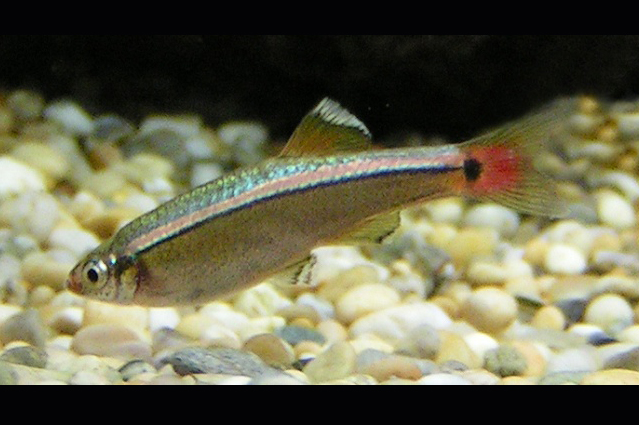Mountain Minnow, Tanichthys albonubes Lin 1932
Other Names: White Cloud Mountain Minnow

Mountain Minnow, Tanichthys albonubes. Source: sannse / Wikimedia Commons. License: CC by Attribution-ShareAlike
Summary:
A small silvery-green to bronze minnow with bright red dorsal and caudal fins, often white margins on the dorsal and anal fins, and a large spot on the caudal-fin base. The more slender males are brighter in colour, and have larger dorsal and anal fins than females.
This popular aquarium fish is native to China where it is endangered in the wild. The species has been accidentally or purposely released into creeks in southern Queensland and central New South Wales.
Cite this page as:
Martin F. Gomon & Dianne J. Bray, Tanichthys albonubes in Fishes of Australia, accessed 02 Jul 2025, https://fishesofaustralia.net.au/home/species/2694
Mountain Minnow, Tanichthys albonubes Lin 1932
More Info
|
Distribution |
Creek in Brisbane, Queensland, and Green Point Creek, Pearl Beach, and Piles Creek, Somersby, New South Wales. The species is a native of China, and is endangered in its native habitat. It has been introduced (through aquarium releases) to a number of countries including Colombia, Madagascar, Philippines, Réunion, Taiwan and United States. Mountain Minnows prefer small streams with slow-flowing weedy areas, and are considered hardy and tolerant of a range of water conditions. While reportedly prefer temperatures ranging between 18-22°C, the can survive higher temperatures, and those as low as 5°C. |
|
Feeding |
Carnivore - feeds on small insect larvae and zooplankton. |
|
Species Citation |
Tanichthys albonubes Lin 1932, Lignan Science Journal, Canton 11(3): 379. Type locality: White Cloud Mountain, Kwangtung, China. |
|
Author |
Martin F. Gomon & Dianne J. Bray |
Mountain Minnow, Tanichthys albonubes Lin 1932
References
Arthington, A.H., Kailola, P.J., Woodland, D.J. & Zalucki, J.M. 1999. Baseline environmental data relevant to an evaluation of quarantine risk potentially associated with the importation to Australia of ornamental finfish. Australian Quarantine and Inspection Service, Department of Agriculture, Fisheries and Forestry, Canberra, ACT, 451 pp.
Bomford, M. & Glover, J. 2004. Risk assessment model for the import and keeping of exotic freshwater and estuarine finfish. Bureau of Rural Sciences, Canberra, ACT, 125 pp.
Chan, B.P.L. & Chen, X. 2009. Discovery of Tanichthys albonubes Lin 1932 (Cyprinidae) on Hainan island, and notes on its ecology. Zoological Research 30(2): 209-214.
Corfield, J., Diggles, B., Jubb, C., McDowall, R.M., Moore, A., Richards, A. & Rowe, D.K. 2008. Review of the impacts of introduced ornamental fish species that have established wild populations in Australia. Prepared for the Australian Government Department of the Environment, Water, Heritage and the Arts. 383 pp.
Fricke, R., Mulochau, T., Durville, P., Chabanet, P., Tessier, E. & Letourneur, Y. 2009. Annotated checklist of the fish species (Pisces) of La Réunion, including a Red List of threatened and declining species. Stuttgarter Beiträge zur Naturkunde A, Neue Serie 2: 1-168.
Lin, S.-Y. 1932. New cyprinid fishes from White Cloud Mountain, Canton. Lingnan Science Journal, Canton 11(3): 379-383.
Lintermans, M. 2004. Human-assisted dispersal of alien freshwater fish in Australia. New Zealand Journal of Marine and Freshwater Research 38(3): 481-501.
McKay, R.J. 1984. Introductions of exotic fishes in Australia. p. 177-199. In Courtenay, W.R. Jr. & Stauffer, J.R. Jr. (eds). Distribution, biology and management of exotic fishes. The John Hopkins University Press, Baltimore, Maryland, USA.
Riehl, R. & Baensch, H.A. 1991. Aquarium Atlas. Mergus, Melle, 992 pp.




